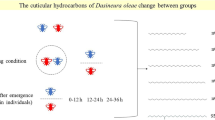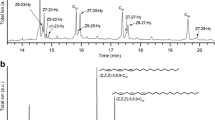Abstract
Mixtures of (Z)-9-alkenes (C21-C33),n-alkanes (C21-C33), and mono- and dimethylalkanes (C27, C29), as components of the cuticular lipids washed from the female housefly (Musca domestica L.), were synthesized and assayed for their biological activity on male houseflies. The (Z)-9-alkenes and their hydrogenatedn-alkanes were synthesized from jojoba wax components by the appropriate chain elongation. The methylalkanes were prepared by Grignard coupling reaction of the appropriate alkyl halides, catalyzed by Li2CuCl4. Six- to 7-day-old virgin male houseflies exhibited the highest mating strike activity toward 6- to 7-day-old virgin females. The mating strike activity of the synthetic hydrocarbons was studied by exposing 6- to 7-day old virgin males to petrol-ether-rinsed 1 to 2-day-old dead females treated with these chemicals. (Z)-9-Tricosene was the most active hydrocarbon tested when it was applied in amounts of 10 μg to a washed dead female. Amounts of 5 μg of (Z)-9-tricosene did not cause sexual activity in the males. Mixture of (Z)-9-alkenes showed low activity when applied at 10-μg amounts. However, when mixtures were made of 5 μg of (Z)-9-tricosene with 5 fig of each of certain mixtures of (Z)-9-alkenes, the striking activity became as high as that of 10 μg of (Z)-9-tricosene. This might be a synergism effect. The mixtures ofn-alkanes, as well as the mono- and dimethylalkanes, showed moderate activity. When (Z)-9-tricosene was added to these materials no increase in male activity was observed.
Similar content being viewed by others
References
Adams, T.S., andHolt, G.G. 1987. Effect of pheromone components when applied to different models on male sexual behaviour in the housefly,Musca domestica.J. Insect Physiol. 33:9–18.
Adams, T.S., Holt, G.G., andBlomquist, G.J. 1984. Endocrine control of pheromone biosynthesis and mating behaviour in the housefly,Musca domestica, pp. 441–457,in Advances in Invertebrate Reproduction, Vol. 3. W. Engels, W.H. Clark, A. Fischer, P.J.W. Oliver, and D.F. Went (eds.). Elsevier Science, Amsterdam.
Adler, V.E., Uebel, E.G., andSchwartz, M. 1984. Production of (Z)-9-tricosene, by colonized and feral female houseflies.Southwest Entomol. 9:223–226.
Carlson, D.A., Mayer, M.S., Silhacek, D.L., James, J.D., Beroza, M., andBierl, B.A. 1971. Sex attractant pheromone of the housefly: Isolation, identification and synthesis.Science 174:76–78.
Carlson, D.A., Doolittle, R.E., Beroza, M., Rogoff, W.M., andGretz, G.H. 1974. Muscalure and related compounds. I. Response of houseflies in olfactometer and pseudofly tests.Agric. Food. Chem. 22:194–197.
Dillwith, J.W., Adams, T.S., andBlomquist, G.J. 1983. Correlation of housefly sex pheromone production with ovarian development.J. Insect Physiol. 29:377–386.
Graille, J., Pina, M., andPioch, D. 1986. Routine analysis of jojoba wax fatty acids and alcohols by single column capillary GC.J. Am. Oil Chem. Soc. 63:111–116.
Mansingh, A., Steele, R.W., Smallman, B.N., Meresz, O., andMozogai, C. 1972. Pheromone effects ofcis-9-long chain alkenes on the common housefly—an improved sex attractant combination.Can. Entomol 104:1963–1965.
Miwa, T.K. 1971. Jojoba oil wax esters and derived fatty acids and alcohols: Gas chromatography analyses.J. Am. Oil Chem. Soc. 48:259–264.
Morgan, P.B., Gilbert, I.H., andFye, R.L. 1974. Evaluation of (Z)-9-tricosene for attractancy forMusca domestica in the field.Fl. Entomol. 57:136–140.
Nelson, D.R., Dillwith, J.W., andBlomquist, G.J. 1981. Cuticular hydrocarbons of the housefly,Musca domestica.Insect Biochem. 11:187–197.
Richter, I. 1974. Sex attraction of the housefly by moving dummies is not increased by pheromones.Naturwissen Schaffen 61:365.
Richter, I., Krain, H., andMangold, H.K. 1976. Long chain (Z)-9-alkenes are “psychedelics” to houseflies with regard to visually stimulated sex attraction and aggregation.Experientia 32:186–188.
Rogoff, W.M., Gretz, G.H., Jacobson, M., andBeroza, M. 1973. Confirmation of (Z)-9-tricosene as a sex pheromone of the housefly.Ann. Entomol. Soc. Am. 66:739–741.
Rogoff, W.M., Gretz, G.H., Sonnet, P.E., andSchwarz, M. 1980. Response of male house-flies to muscalure and to combinations of hydrocarbons with and without muscalure.Environ. Entomol. 9:605–606.
Shani, A. 1979. An efficient synthesis of muscalure from jojoba oil or oleyl alcohol.J. Chem. Ecol. 5:557–564.
Silhacek, D.L., Mayer, M.S., Carlson, D.A., andJames, J.D. 1972a. Chemical classification of a male housefly attractant.J. Insect Physiol. 18:43–51.
Silhacek, D.L., Carlson, D.A., Mayer, M.S., andJames, J.D. 1972b. Composition and sex attractancy of cuticular hydrocarbons from houseflies: Effects of age, sex and mating.J. Insect Physiol. 18:347–354.
Tamura, M., andKochi, J. 1974. Coupling of Grignard reagents with organic halides.Synthesis 1974:303–305.
Uebel, B.C., Sonnet, P.E., andMiller, R.W. 1976. Housefly sex pheromone: Enhancement of mating strike activity by combination of (Z)-9-tricosene with branched saturated hydrocarbons.Environ. Entomol. 5:905–908.
Uebel, E.C., Schwarz, M., Lusby, W.R., Miller, R.W., andSonnet, P.E. 1978. Cuticular non-hydrocarbons of the female housefly and their evaluation as mating stimulants.Llyodia 41:63–67.
Author information
Authors and Affiliations
Rights and permissions
About this article
Cite this article
La-France, D., Shani, A. & Margalit, J. Biological activity of synthetic hydrocarbon mixtures of cuticular components of the female housefly (Musca domestica L.). J Chem Ecol 15, 1475–1490 (1989). https://doi.org/10.1007/BF01012377
Received:
Accepted:
Issue Date:
DOI: https://doi.org/10.1007/BF01012377




